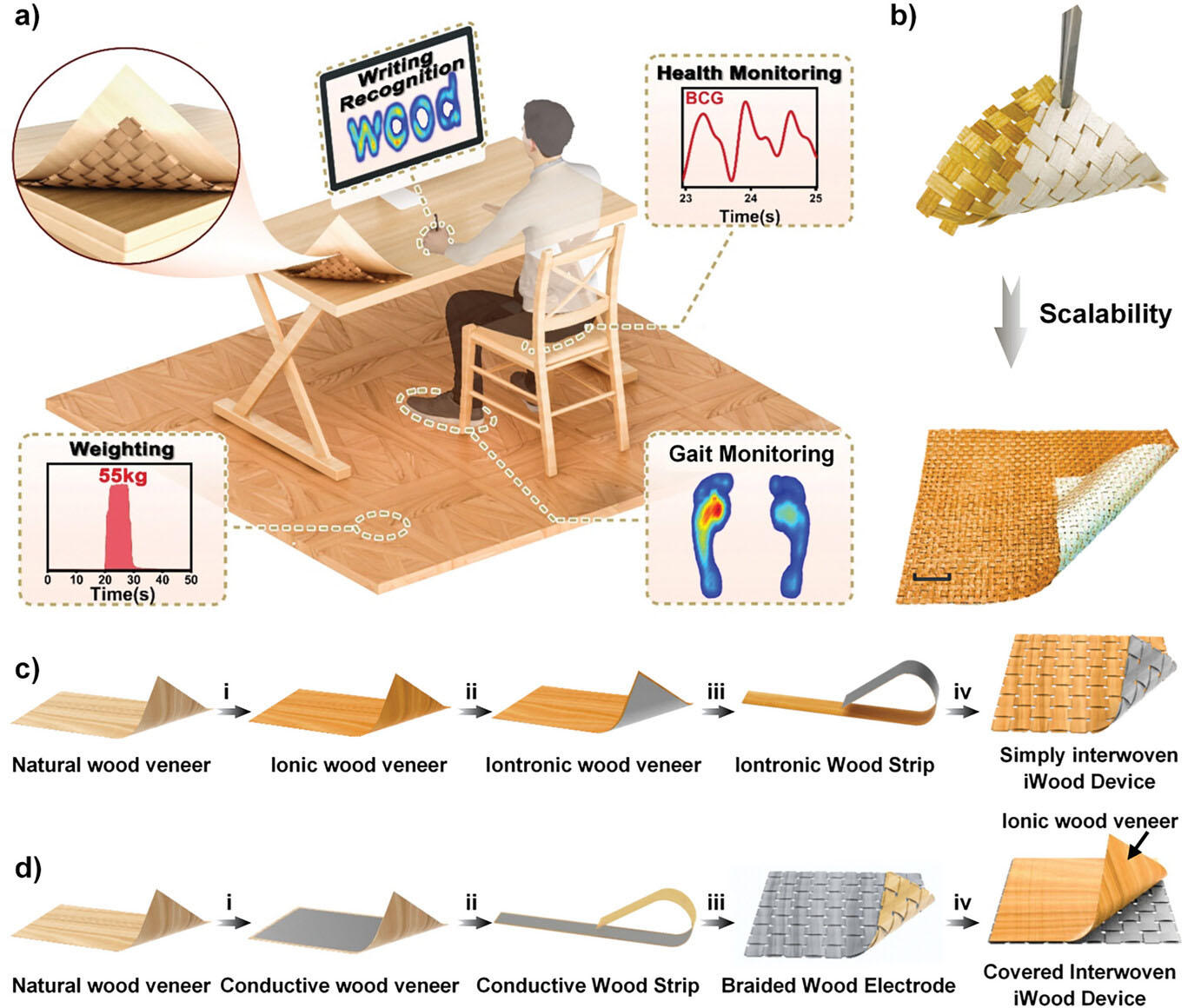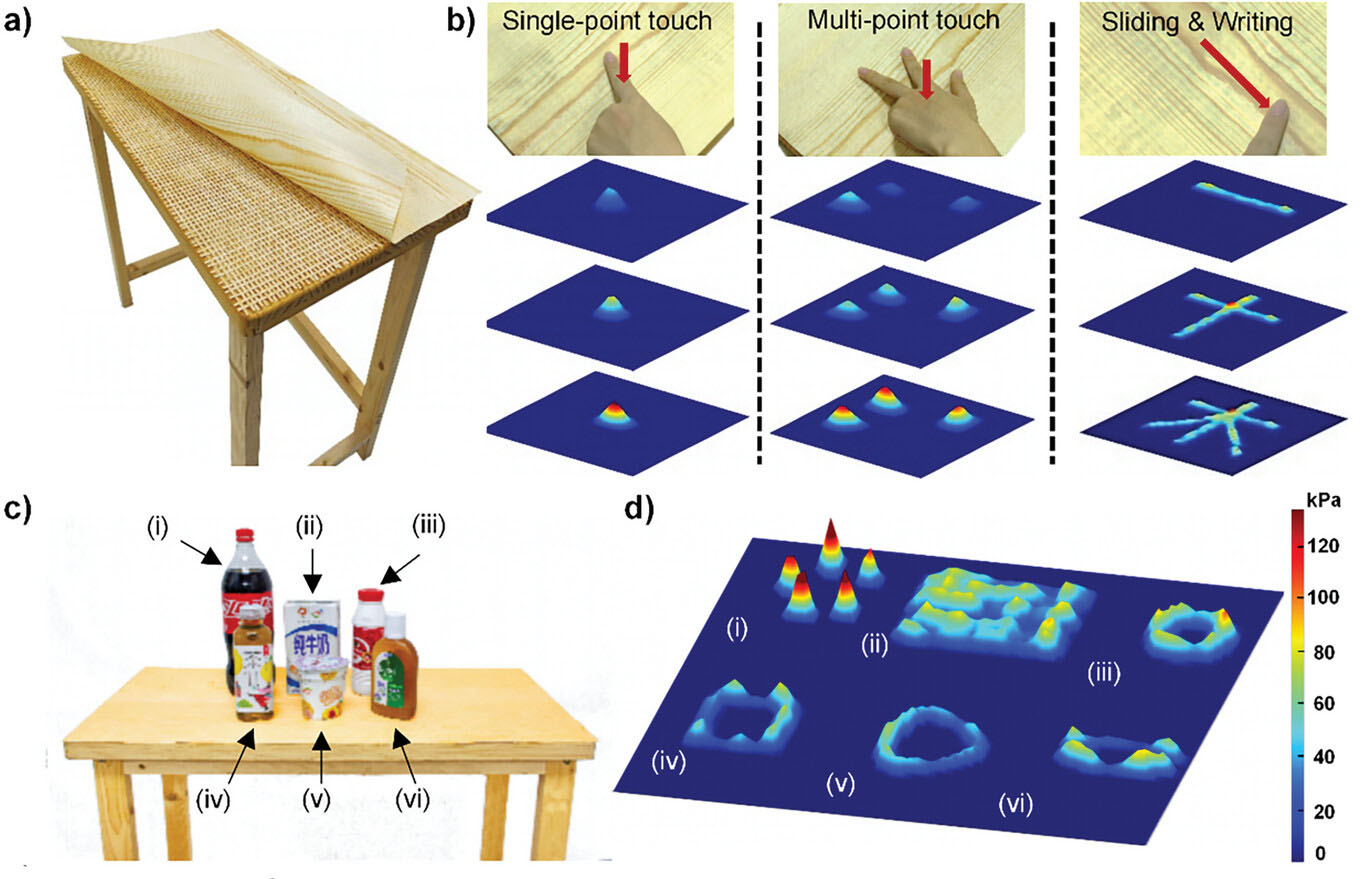| Mar 20, 2024 | |
iWood technology - integrating tactile sensing with natural wood for smart, responsive environments |
|
| (Nanowerk Spotlight) Wood is one of the oldest and most ubiquitous materials used by humans, with applications spanning construction, furniture, flooring, and beyond. For centuries, wood has served as the interface through which we interact with our built environment. However, while wood excels in its mechanical and aesthetic properties, it has historically lacked the ability to intelligently sense and respond to the human touch. | |
| Scientists and engineers have been seeking to imbue wood and wood-derived materials with tactile sensing capabilities to capture the valuable information generated when humans physically interact with wooden objects and surfaces. Previous research efforts have demonstrated approaches such as carbonizing wood into porous, conductive sponges, coating wood with graphene, or infiltrating wood with conductive gel composites. While showcasing interesting proofs-of-concept, these prior technologies faced limitations in their ability to be seamlessly integrated into wooden objects at scale without compromising the innate look, feel and performance of the wood itself. | |
| However, recent advancements in the emerging field of iontronic sensing have opened up new possibilities for realizing intelligent wood that maintains its original properties. Iontronic sensors leverage the unique electrical properties of ionic-electronic interfaces to achieve extraordinarily high-pressure sensitivity. | |
| Crucially, since ionic conductors and electrolytes are ubiquitous in nature, iontronic sensing can in principle be implemented in almost any material—including wood – simply by introducing a conductive medium. This technology therefore provides a promising pathway to seamlessly endow wood with tactile awareness. | |
| Building upon this potential, a team of researchers in China has now developed an intelligent iontronic wood (iWood) device that integrates highly sensitive pressure mapping capabilities into natural wood through a scalable and non-destructive manufacturing process. As described in their recent paper published in Advanced Functional Materials ("iWood: An Intelligent Iontronic Device for Human-Wood Interactions"), the innovation enables wooden objects and surfaces to dynamically sense and digitize complex human touch interactions without any change to the underlying material. | |
 |
|
| a) Schematic illustration of human-wood interactions using the iWood device. b) The photos of the scalable iWood device using the braiding process. c) The preparation of the simply interwoven iWood device. i) Ionizing of natural wood veneer into ionic wood veneer, ii) surface metallization of ionic wood veneer into iontronic wood veneer, iii) cutting iontronic wood veneer into strips, iv) braiding iontronic wood strips into the simply interwoven iWood device. d) The preparation of the covered interwoven iWood device. i) Surface metallization of natural wood veneer into conductive wood veneer, ii) cutting conductive wood veneer into strips, iii) braiding conductive wood strips into the braided wood electrode, iv) covering ionic wood veneer on the electrode to form the covered interwoven iWood device. (Reprinted with permission by Wiley-VCH Verlag) | |
| At the core of the iWood device is a specially developed "ionic wood" material, created by infusing natural wood with an ionic liquid which is then immobilized via hydrogen bonding to the cellulose fibers. This process leverages the natural porosity and structural channels in wood to achieve an even distribution of ionic species without disrupting the integrity of the wood on a macroscopic level. | |
| Notably, the researchers optimized the ionic wood to possess both high ionic conductivity for electrical sensitivity and excellent mechanical stability to prevent ionic liquid leakage even under large pressures. | |
| To construct functional iWood devices, thin flexible strips of the ionic wood are interwoven together in a grid-like architecture, with some of the strips selectively coated in metal to serve as conductive electrodes. Each intersection between an ionic wood strip and a conductive wood strip forms a pixel-like sensing node, in which the contact pressure modulates the capacitance of the ionic-electronic interface. By measuring this capacitance change in each pixel, the iWood device generates a high-resolution pressure map. | |
| Through rigorous mechanical modeling and testing, the researchers systematically optimized the performance of the iWood device, assessing key parameters such as sensitivity, pressure range, response speed, and durability. The results demonstrate that the iWood achieves a remarkable sensitivity of over 30 nanoFarads per kilopascal, a rapid response time under 5 milliseconds, and consistent performance over more than 10,000 loading cycles. Further customization of the ionic wood properties, for example by tuning the porosity through chemical treatment, enabled the sensing range and sensitivity to be tailored for different applications. | |
| To validate the real-world functionality of the technology, the team fabricated a series of proofs-of-concept spanning interactive desktops, health-monitoring chairs, and intelligent floors. For instance, a 3,600 square centimeter iWood desktop demonstrated accurate touch tracking, gesture recognition, and object classification based on the high-resolution pressure patterns generated through normal human interaction with the wooden surface. Impressively, a machine learning classifier trained on the iWood touch data achieved over 99% accuracy in identifying different objects placed on the desk based solely on their pressure footprint. | |
 |
|
| a) Photograph of the iWood desk with the covered interwoven device architecture revealed, along with b) the image of the pressure mapping results following the single-point touch, multi-point touch, sliding, and writing. c) Photograph of different objects placed on the iWood desk, followed by d) the corresponding characteristic images of their contact pressure distribution. The numbers in c) and d) represent i) Cola drink bottle, ii) Tetra Pak milk, iii) the dairy glass bottle, iv) the tea beverage container, v) the plastic yogurt packaging, and vi) the mouthwash bottle respectively. (Reprinted with permission by Wiley-VCH Verlag) | |
| In another compelling demonstration, an iWood floor was able to serve as a comprehensive gait and balance analysis tool by capturing the dynamic pressure distribution underneath an individual's feet while standing, walking and jumping. By computing parameters such as the center of pressure trajectory and ground reaction force curve, the intelligent wood surface can provide clinical-grade insights into a person's biomechanics and stability without the need for obtrusive wearable sensors or dedicated equipment. | |
| Perhaps most promisingly, the researchers showed that an iWood chair can continuously monitor a user's heart rate and respiration based on the subtle pressure variations generated by the body's ballistic forces. This use case points to a future in which health-critical information could be seamlessly captured through everyday interactions with ordinary objects and environments. | |
| Looking ahead, the innovations introduced by the iWood device open up vast possibilities for reimagining how humans engage with the wooden objects that surround us every day. By making wood itself innately intelligent and responsive, this technology takes a significant step towards realizing the full potential of smart environments and interactive interfaces. While the iWood is still a research prototype, one can envision a future where hyper-aware wooden surfaces are ubiquitous in our homes, workplaces, and public spaces—silently and unobtrusively monitoring our wellbeing and enhancing our daily lives. | |
| Though challenges remain in scaling up the iWood technology and validating its long-term reliability, the core concepts and materials innovations are sound. As such, it likely represents not the conclusion but rather the beginning of a new paradigm, in which even the most ancient and foundational of materials can become imbued with artificial intelligence. In our increasingly sensor-laden and data-driven world, the prospect of smart wood may have once seemed like a contradiction in terms. But with innovations like the iWood device emerging from research labs around the world, it might not be long before the very foundations of our built environment can engage with us like never before. | |
 By
Michael
Berger
– Michael is author of three books by the Royal Society of Chemistry:
Nano-Society: Pushing the Boundaries of Technology,
Nanotechnology: The Future is Tiny, and
Nanoengineering: The Skills and Tools Making Technology Invisible
Copyright ©
Nanowerk LLC
By
Michael
Berger
– Michael is author of three books by the Royal Society of Chemistry:
Nano-Society: Pushing the Boundaries of Technology,
Nanotechnology: The Future is Tiny, and
Nanoengineering: The Skills and Tools Making Technology Invisible
Copyright ©
Nanowerk LLC
|
|
|
Become a Spotlight guest author! Join our large and growing group of guest contributors. Have you just published a scientific paper or have other exciting developments to share with the nanotechnology community? Here is how to publish on nanowerk.com. |
|
